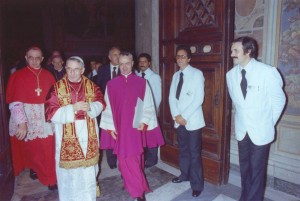 Today in 1978, Albino Luciani, the Patriarch of Venice, was elected the Roman Pontiff. He took the name, Pope John Paul I.
Today in 1978, Albino Luciani, the Patriarch of Venice, was elected the Roman Pontiff. He took the name, Pope John Paul I.
The papacy of John Paul was 33 days long.
His cause is being studied for possible beatification.
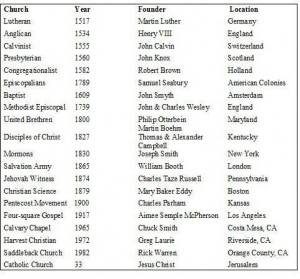 I saw a bumper sticker several years ago that read: “Preaching Jesus Christ since 33 A.D.” One of the Orthodox Churches published it as a way of saying that truth, beauty, goodness and unity are given by Jesus Christ; Christ and the church is not a system of beliefs or policies created at-will. Read carefully the image here.
I saw a bumper sticker several years ago that read: “Preaching Jesus Christ since 33 A.D.” One of the Orthodox Churches published it as a way of saying that truth, beauty, goodness and unity are given by Jesus Christ; Christ and the church is not a system of beliefs or policies created at-will. Read carefully the image here.
There is always the perennial question about following Christ in the Catholic Church: Why does it matter if you leave the Catholic Church? Does it matter if I stay in the Church?
You can have several approaches to the question, but here are the essentials:
1. the truth claims in God as One and Triune; that God is Being itself; that all beauty and unity are defining characteristics of Father, Son and Holy Spirit;
2. Grace –the inner life of the Triune God, not sin, is given to the Catholic Church because its founder, Jesus Christ;
3. Jesus gave his apostles the grace of the sacred Priesthood, and the other sacraments; the Church gave us the Holy Bible, our sacred Scripture revealed by God;
4. Saint Peter was given the pastoral authority and power to preach, teach, and lead the Church to the fullness of the truth, Christ Himself (Matthew 16; 17-19);
5. the power to forgive sins was given by Christ to Peter and Peter to those anointed to share in his ministry down through the ages (apostolic succession, it is called); we follow the Master in the unity and sacramentality of the Church.
Hence, he Catholic Church, was founded by Jesus and she contains the fullness of truth, as promised by Jesus Himself.
The Church is not merely one among many denominations. The Holy Spirit does not divide the truth; there are not personal versions of the truth that claim to set man and woman free. We believe in the objectivity of truth and this truth is not a thing, but a person. There is one Church only: the Catholic Church. In the USA we encounter many groups who claim to be a “church” and to have the fullness of truth. Yet, the question needs to be raised: what do we think of the Protestant groups? The teaching of the Catholic states that each of the groups have some aspect of truth but they do not have the fullness of the truth as revealed by Scripture because they lack valid priesthood and therefore valid sacraments (very few have 7 sacraments that are believed to be instituted by Christ to give grace). As a caveat, we teach and hold that the Orthodox Church has the fullness of truth and sacraments but it lacks true unity with the Body of Christ on earth. One day we will share the Holy Eucharist with the Orthodox.
Catholics are not perfect and they are certainly not holier than other Christians. We are a church of sinners seeking redemption in Christ Jesus. Our belief is that the Catholic Church is both human and divine. And because she shares in Christ’s divinity, it is holy and she will last forever (“I am with you always, to the close of the age.” Matthew 28:19-20). The human side of the church explains the sins, the scandals, unfaithfulness of the people. Logically, though, you cannot claim that the presence of scandals and singer prove that the Catholic Church is false. It proves we need a Savior.
Considering the Christian ecclesial communities and churches, historically we can say that ONLY the Catholic Church existed since the time of Jesus. All other Christian churches have broken from the Catholic Church. Examples: Orthodoxy broke away from unity with the pope in 1054; various mainline Protestant communities were established during the Reformation (1517); and then many of the other smaller groups are breakaways from the Protestant communion.
It is recorded that Church history has lead many unbelievers to search and know the truth. History will demonstrate what the early Church believed about the Eucharist (the Real Presence of Christ in the Eucharist); how and why the early Christians prayed for the dead; what the Lord gave to the Apostles in terms of sacraments; Peter was clearly chosen by the Lord as the leader of His Church; that Mary was loved and honored by the early Christians and understood as the All-holy Mother of God.
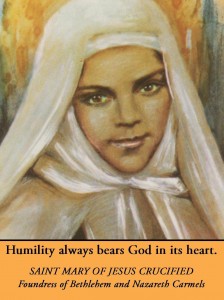 The saints lead us to a deeper relationship with Christ. A new saint of ours, Mary of Jesus Crucified (1846-1878), known in history as Mariam Baouardy (also spelled Mariam Bawardy) was a Carmelite nun. She as a Stigmatic and Victim Soul. She was a communicant of the Melkite Church.
The saints lead us to a deeper relationship with Christ. A new saint of ours, Mary of Jesus Crucified (1846-1878), known in history as Mariam Baouardy (also spelled Mariam Bawardy) was a Carmelite nun. She as a Stigmatic and Victim Soul. She was a communicant of the Melkite Church.
You can read more of her history here.
The biographer of Saint Mary of Jesus says that she heard in a clear voice from Jesus, “This is how everything passes. If you will give me your heart, I shall always remain with you.” These words penetrated and took root in the young heart of Mariam.
Saint Mary of Jesus Crucified, as a Palestinian Carmelite nun was recognized as being filled with the gifts and charisms of the Holy Spirit to an extraordinary degree (think of St Paul). Her mission now is to intercede for us with the Trinity; no doubt one her intentions is ask for the gift of conversion of Islam to Jesus Christ.
Pray to her for peace in the world and Church.
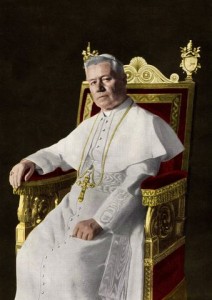 We honor the memory of Saint Pius X, known in history as Giuseppe Melchiorre Sarto. He was the Roman Pontiff from 1903 to 1914. It was 101 years ago that Pope Pius X went to his eternal reward. His last will and testament stated, “I was born poor, I have lived poor, I wish to die poor.” He is known for several instructions on our participation in the holy mysteries: the liturgy of the church.
We honor the memory of Saint Pius X, known in history as Giuseppe Melchiorre Sarto. He was the Roman Pontiff from 1903 to 1914. It was 101 years ago that Pope Pius X went to his eternal reward. His last will and testament stated, “I was born poor, I have lived poor, I wish to die poor.” He is known for several instructions on our participation in the holy mysteries: the liturgy of the church.
The Church prays:
O God, Who didst raise up Saint Pius X to be the chief Shepherd of Thy flock and especially endowed him with devotion to the Blessed Sacrament of the Altar and zeal for Thine eternal truths and a love of the priesthood and the Holy Sacrifice of the Mass, grant we beg of Thee, that we who venerate his memory on earth, may enjoy his powerful intercession in Heaven.
What work did Pope Pius X do for the Church? A lot. He worked the sacred liturgy, the chant tradition and the reform of code canon law; he put energy to improve clergy training and discipline; he established a foundation for scriptural studies and inaugurated the revision of the Latin text of the Bible (we know it as the Vulgate). In the world of politics he emphasized the separation of Church and State and opposed political organizations laying claim to religious sanction. The work that was very dear to heart was his work for peace in the shadows of the outbreak of WWI.
If you want to read some brilliant literature, I’d recommend the Sunday homilies he preached in the courtyards of the Vatican on his favourite theme: the restoration of all things in Christ and the ushering in of peace on earth. One will recall that the restoration of all things in Christ is his motto.
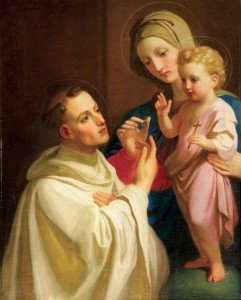 Saint Bernard of Clairvaux composed the famous prayer to the Most Blessed Virgin Mary known as The Memorare. This year is Bernard’s 900th anniversary!
Saint Bernard of Clairvaux composed the famous prayer to the Most Blessed Virgin Mary known as The Memorare. This year is Bernard’s 900th anniversary!
MEMORARE, O piissima Virgo Maria, non esse auditum a saeculo, quemquam ad tua currentem praesidia, tua implorantem auxilia, tua petentem suffragia, esse derelictum. Ego tali animatus confidentia, ad te, Virgo Virginum, Mater, curro, ad te venio, coram te gemens peccator assisto. Noli, Mater Verbi, verba mea despicere; sed audi propitia et exaudi. Amen.
REMEMBER, O most gracious Virgin Mary, that never was it known that anyone who fled to thy protection, implored thy help, or sought thy intercession was left unaided. Inspired with this confidence, I fly to thee, O Virgin of virgins, my Mother; to thee do I come; before thee I stand, sinful and sorrowful. O Mother of the Word Incarnate, despise not my petitions, but in thy mercy hear and answer me. Amen.
Will you join other people across the United States for the 2015 National 54 Day Rosary Novena???
This novena’s primary intention is “For Family and Marriage.”
Would you pray the rosary every day during the 54-day novena (August 15-October 7) for the intention of holy marriages and holy families.
October 7th is the Memorial of Our Lady of the Rosary.
“The National 54 Day Rosary Novena serves as a Message of Hope in response to the spiritual crisis in our culture and nation regarding marriage and family, and in response to the U.S. Conference of Catholic Bishops call to unite in prayer for the intention of the sanctity of marriage and family life. While a novena normally consists of nine consecutive days of prayer, this 54-day rosary novena could be considered an extended novena for this specific intention.”
We are still on the path that Christ has given Mother Church: eternal life. It takes a long time to accept the fact the God the Father through His Son Jesus nourishes, strengthens, and guides our way through all of life’s challenges. Within human limit we are given grace. The matter is: do recognize the graces? These weeks we are given extensive sections of the Bread of Life discourse; John 6 is our text for meditation.
Accepting that Jesus is THE answer takes a long time
Yesterday, after Mass, I spoke with a friend who is a few years my senior who told me she is now learning what it means ‘to give all to God.’ She freely admits (I can relate to the experience) that she always seems to have a fingernail of reality saved of the self reserved for herself. Thus, she knows that not everything is given to God. The spiritual masters, as we have heard, tell us that we need to abandon everything to the Lord. Yes, all things are given to Christ change; nothing is reserved for the self –absolutely nothing. I find this advice to be true, but rather difficult to live because I always want to keep something for myself. Deep down the difficulty surfaces because I don’t trust enough the relationship I have with the Lord; eternal life is not a merit badge for a life well-lived. In other words: do believe the promises of the Lord are too good to be true?
What I am finding more and more among those who claim to be in relationship, friendship with Christ (i.e., those who claim for themselves to be “good Catholics”) is how shallow said relationship with the Lord really is. What I am finding from people a bunch of alternative reasons NOT to worship Him (the 3rd commandment), not to serve our neighbor (MT 25), not to live in the Mystical Body of Christ –the Church (St Paul), are too prevalent and easy. Too many Catholics are zombies.
The first reading for today’s Mass comes from the Book of Proverbs which tells us that our task in the spiritual life is about ‘forsaking foolishness’. What is foolishness? Foolishness can be seen as anxiety, worry, sin, making excuses, expressed anger, addictions, living with a lack of a pure heart –all leading to being unfaithful and spiritual and human death. Foolishness unworthy of the Eucharist. Only being faithful to Jesus Christ will give us eternal life (permanent life, peace and love, beatific vision –communio with the Trinity). Faithfulness to whom? Only to Jesus Christ will fulfill our hunger for eucharistic living. Only to Jesus in the Holy Eucharist leads us to eternal life. This eucharistic theme is explained by the Holy Father.
Before we get to Pope Francis let us consider what the great Saint Irenaeus taught: “Just as the bread that is made from the earth, when it receives the invocation of God, is no longer ordinary bread but the Eucharist, consisting of two realities, earthly and heavenly, so also our bodies when they receive the Eucharist are no longer corruptible, having the hope of the resurrection to eternity.” Is this what we really believe?
The Sunday Angelus (8/16/15) address by Pope Francis told us today:
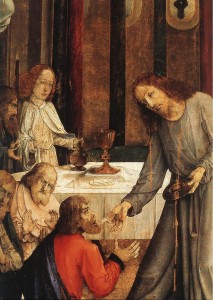 On these Sundays, the Liturgy proposes to us, from the Gospel of John, Jesus’ discourse on the Bread of Life, that is He Himself and that is also the Sacrament of the Eucharist. Today’s passage (Jn. 6, 51-58) presents the last part of that discourse, and refers to some of those among the people who are scandalized because Jesus said: “Whoever eats my flesh and drinks my blood has eternal life, and I will raise him on the last day” (Jn. 6,54).
On these Sundays, the Liturgy proposes to us, from the Gospel of John, Jesus’ discourse on the Bread of Life, that is He Himself and that is also the Sacrament of the Eucharist. Today’s passage (Jn. 6, 51-58) presents the last part of that discourse, and refers to some of those among the people who are scandalized because Jesus said: “Whoever eats my flesh and drinks my blood has eternal life, and I will raise him on the last day” (Jn. 6,54).
The astonishment of those listening is understandable; in fact, Jesus uses the typical style of the prophets to provoke in the people – and also in us – questions and, in the end, to make a decision. The first of the questions is: What does “eat Jesus’ flesh and drink his blood” mean? Is it only an image, a way of saying, a symbol, or does it indicate something real? To answer this, one needs to guess what is happening in Jesus’ heart while he breaks the bread for the hungry crowd. Knowing that He must die on the cross for us, Jesus identifies Himself with that broken and shared bread, and that becomes for Him the “sign” of the Sacrifice that awaits Him. This process culminates in the Last Supper, where the bread and wine truly become His Body and His Blood.
It is the Eucharist where Jesus leaves us a precise purpose: that we can become one with Him. In fact, he says: “Whoever eats my flesh and drinks my blood remains in me and I in him” (v.56). To remain: Jesus in us and us in Him. Communion is assimilation: eating Him, we become Him. But this requires our “yes”, our adherence to the faith.
At times, during the Holy Mass, it may happen to feel this objection: “What is the purpose of the Mass? I go in Church when I feel like it, and I pray better alone.” But the Eucharist is not a private prayer or a beautiful spiritual experience, it is not a simple commemoration of what Jesus has done in the Last Supper: we say, to understand well, that the Eucharist is a “memorial”, that is, an act that actualizes and makes present the event of the death and resurrection of Jesus: the bread is truly His Body given to us; the wine is truly His Blood that has been shed.
The Eucharist is Jesus who gives Himself entirely to us. By nourishing ourselves from Him and remaining in Him through the Eucharistic Communion, if we do it with faith, it transforms our life; it transforms it into a gift to God and a gift to our brothers. To nourish ourselves from that “bread of life” means being in tune with the heart of Christ, to assimilate His choices, His thoughts, His behavior. It means entering into a dynamic of sacrificial love and become a person of peace, of forgiveness, of reconciliation of sharing in solidarity. It is the same as Jesus has done.
Jesus concludes his discourse with these words; “Whoever eats this bread will live forever” (Jn. 6,58). Yes, living in a concrete, real communion with Jesus on this earth makes us pass from death to life. The heavens begin precisely in this communion with Jesus.
In Heaven, Mary our Mother awaits us – yesterday we celebrated this mystery. May She obtain for us the grace of nourishing ourselves always with faith in Jesus, the Bread of Life.
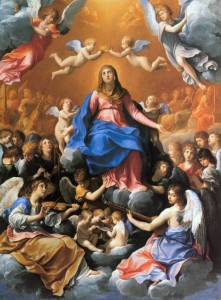 The perfect union of the Blessed Virgin Mary with God
The perfect union of the Blessed Virgin Mary with God
Mid-August finds a good many of the Eastern and Western churches commemorating the move of Mary to heaven. In the East the feast is called the Dormition (koímesis); in the West it is called the Assumption (assumptio). This is a favorite feast for me.
St. Germanus of Constantinople preached: “You, O Mother, are close to all and protect all, and though our eyes cannot see you, we know, O Most Holy One, that you dwell among us and make yourself present in the most varied ways… Your virginal body is entirely holy, entirely chaste, entirely God’s dwelling place so for this reason it is absolutely incorruptible. It is unchangeable since what was human in it has been taken up in incorruptibility, remaining alive and absolutely glorious, undamaged, and sharing in perfect life. Indeed, it was impossible that the one who had become the vase of God and the living temple of the most holy divinity of the Only Begotten One be enclosed in a tomb of the dead. Rather, we certainly believe you continue to walk with us.”
The observance of the feast dates back to the first millennium and defined in the 20th century. Mary is a figure of the heavenly Jerusalem!
We know from liturgical historical scholarship that Several Armenian lectionaries found in Jerusalem witness to a celebration of Mary as Theotókos on August 15; the documents tell us this feast arose in the fifth century, probably after the Council of Ephesus in 431. The Eastern feast was imposed on the entire Byzantine Empire by the Emperor Mauritius at the end of the sixth century. It spread to the West and since the eighth century it has been known as the “assumption” of the Blessed Virgin Mary. In comparison, the Coptic Church liturgically commemorates the Virgin’s death and assumption on two different days. You will recall that the Catholic official teaching –definitely defined– happened not in the early centuries of Church history, but on November 1, 1950. Pope Pius XII taught that according to the tradition Mary was raised body and soul to the glory of heaven was proclaimed a dogma.
The 4 canonical Gospels do not speak of Mary’s later years. But it’s the apocryphal Gospels which speak of Mary dying with the apostles gathered around her, and of her later appearing to them as they celebrate the Eucharistic sacrifice. What do we have about Mary’s ultimate existence on earth? The Church uses the apocryphal Gospels together with the fact that no certain relic of Mary’s body exists thus giving the Church room to contemplate the last moments of Mary’s life on earth in the light of Christ’s victory over death. Hence, we bless flowers and herbs on this feast (indicating no mortal remains was left in the tomb carved for Mary) and we teach that what was gifted to Mary is gifted by the Savior to us who believe in Him.
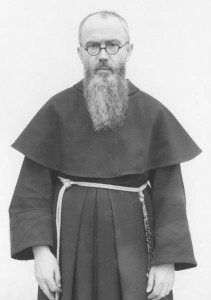 Today is the feast day of one of the great saints of the 20th Century, the Conventual Franciscan Maximilian Kolbe. I can remember hearing his name for the first time and his canonization by Saint John Paul. Years later I visited the cell in which he lived his last days at the concentration camp. A rather moving and unforgettable experience.
Today is the feast day of one of the great saints of the 20th Century, the Conventual Franciscan Maximilian Kolbe. I can remember hearing his name for the first time and his canonization by Saint John Paul. Years later I visited the cell in which he lived his last days at the concentration camp. A rather moving and unforgettable experience.
Saint Maximilian is known for his great devotion to our Blessed Mother in devotion to her Immaculate Heart. There is no coincidence that Kolbe’s feast day comes before Mary’s Assumption (Dormition) -the glorification of her body and soul, assumed into heaven. We know that “Hail Mary!” were the last words on the lips of Saint Maximilian, as he offered his arm to the executioner for the injection. He has taught us what is meant by the words we pray to Immaculate Mary when we say “now and at the hour of our death.”
Kolbe and others were accused by the powers of Nazi Germany of promoting anti-Nazi causes and housing Jews; he was severely mistreated for being a Catholic priest and remaining steadfast to the Faith: Christ was everything, not just some abstract priority. Kolbe regularly celebrated the Holy Sacrifice in secret and heard confessions of fellow prisoners. In 1941, the time came for him to make a sacrifice of his own life, in place of a married prisoner who was father to young children. Kolbe was executed by lethal injection after three weeks of starvation and dehydration. A horrible death.
Saint Maximilian Kolbe, pray for us.
There is a new expression of religious life for women in the Maronite Church in the USA with the Congregation of Sisters called the Maronite Servants of Christ the Light. They were founded in 2008 under the guidance of Bishop Gregory Mansour. Even if you are not discerning a vocation, I would recommend watching this video.
Here’s the blog: Radiate His Light